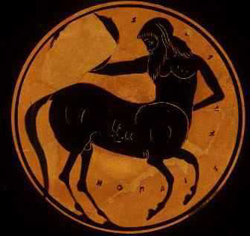Seeing Centaurs
 It is written that when the Maya people of The New World were first set upon by the Spanish cavalry it was spiritual confusion that hastened their demise. To their eyes the seething onslaught of man and horse was made of but one, new and terrifying, species of creature. In the West we might call these creatures Centaurs: liminal entities fused of two distinct species. To the Maya the border between God and beast was breached by the Spanish invaders, truly alien beings who in all but one generation would subsume the Maya under a wave of technology, disease and colonial ascent.
It is written that when the Maya people of The New World were first set upon by the Spanish cavalry it was spiritual confusion that hastened their demise. To their eyes the seething onslaught of man and horse was made of but one, new and terrifying, species of creature. In the West we might call these creatures Centaurs: liminal entities fused of two distinct species. To the Maya the border between God and beast was breached by the Spanish invaders, truly alien beings who in all but one generation would subsume the Maya under a wave of technology, disease and colonial ascent.
At the time these stories first made their way across the Atlantic ocean the Mayan Centaurs would have been seen as examples of a primitive world view. Today we tend to believe we have a clearer conception of history, one not marred by colonial aspirations or archaic stereotypes. And yet, like Edwin Hubble, staring out at an ever expanding universe, the more we look at historical events the more they seem to accelerate away from us.
I am fascinated in the appearance of things, or more precisely, in how things continue to appear the more we examine them. Like the Maya we are constrained by our perceiving eye, by the cultural reservoir within which our perceptions swim. It is as though the very fidelity of reality is determined at its point of viewing, that in some sense we will always see Centaurs where really there sit men on their horses.